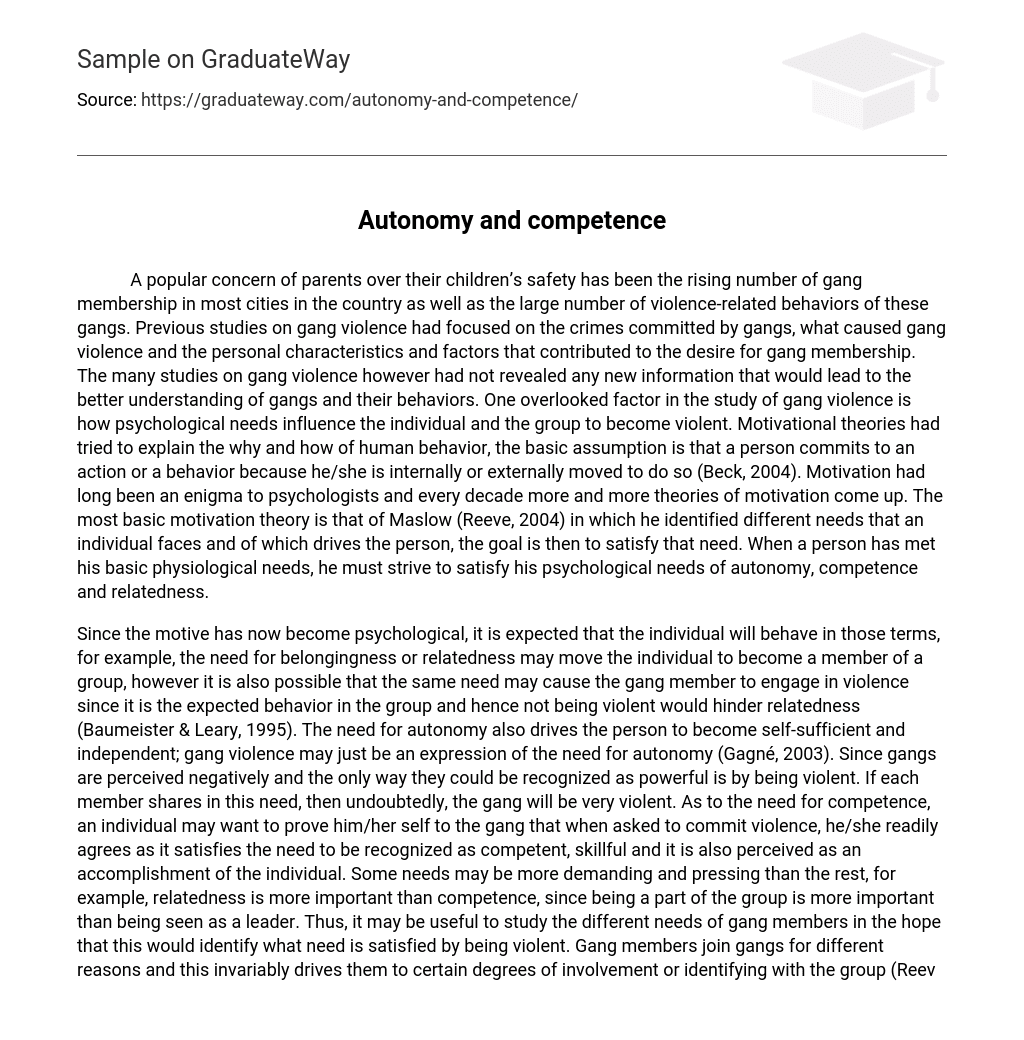A popular concern of parents over their children’s safety has been the rising number of gang membership in most cities in the country as well as the large number of violence-related behaviors of these gangs. Previous studies on gang violence had focused on the crimes committed by gangs, what caused gang violence and the personal characteristics and factors that contributed to the desire for gang membership. The many studies on gang violence however had not revealed any new information that would lead to the better understanding of gangs and their behaviors. One overlooked factor in the study of gang violence is how psychological needs influence the individual and the group to become violent. Motivational theories had tried to explain the why and how of human behavior, the basic assumption is that a person commits to an action or a behavior because he/she is internally or externally moved to do so (Beck, 2004). Motivation had long been an enigma to psychologists and every decade more and more theories of motivation come up. The most basic motivation theory is that of Maslow (Reeve, 2004) in which he identified different needs that an individual faces and of which drives the person, the goal is then to satisfy that need. When a person has met his basic physiological needs, he must strive to satisfy his psychological needs of autonomy, competence and relatedness.
Since the motive has now become psychological, it is expected that the individual will behave in those terms, for example, the need for belongingness or relatedness may move the individual to become a member of a group, however it is also possible that the same need may cause the gang member to engage in violence since it is the expected behavior in the group and hence not being violent would hinder relatedness (Baumeister & Leary, 1995). The need for autonomy also drives the person to become self-sufficient and independent; gang violence may just be an expression of the need for autonomy (Gagné, 2003). Since gangs are perceived negatively and the only way they could be recognized as powerful is by being violent. If each member shares in this need, then undoubtedly, the gang will be very violent. As to the need for competence, an individual may want to prove him/her self to the gang that when asked to commit violence, he/she readily agrees as it satisfies the need to be recognized as competent, skillful and it is also perceived as an accomplishment of the individual. Some needs may be more demanding and pressing than the rest, for example, relatedness is more important than competence, since being a part of the group is more important than being seen as a leader. Thus, it may be useful to study the different needs of gang members in the hope that this would identify what need is satisfied by being violent. Gang members join gangs for different reasons and this invariably drives them to certain degrees of involvement or identifying with the group (Reeve, 2004).
The psychological needs are important to study in changing behavior since it tells us what it is that they value and what behaviors they engage in to satisfy that need. Take for example a program intervention that targets juvenile delinquents, the program is good and positive however it fails to meet its objectives of teaching delinquents anger management skills since most of the target group does not think that they are delinquents because they are angry most of the time. This means that the program was not able to address the need of the delinquents for relatedness given that most of them come from foster families and the like. Knowing what psychological needs gang members have would help me design and develop strategies that would offer gangs a means of satisfying their psychological needs and at the same time modifying their behavior from negative to positive.
References
Baumeister, R. & Leary, M. (1995). The need to belong: Desire for interpersonal attachments as
a fundamental human motivation. Psychological Bulletin, 117; 3, 497-529.
Beck, R. (2004). Motivation: Theories and Principles 5th ed. New Jersey: Pearson/Prentice-Hall.
Gagné, M. (2003). The role of autonomy support and autonomy orientation in prosocial behavior
engagement. Motivation and Emotion, 27, 199-223.
Reeve, J. (2004). Understanding Motivation and Emotion 4th ed. Boston: Harcourt College
Publishers.





